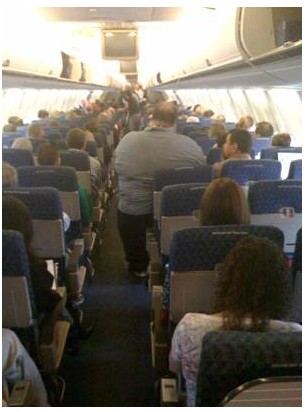The Australian airlines are adamant about the obesity outbreak: there will be no “Fat Controllers” demanding double the fare from people of size trying to fit into their seats as applies to Air France KLM flights from April 1.
But this doesn’t compute. Why aren’t the airlines grabbing the chance to charge fat people more?
Because that would be illegal. Obesity isn’t defined as a disability in law in this country. This means fat people have to be treated as equal to everyone else in the availability of fares to avoid offending the anti-discrimination laws. They must be accommodated not excluded, except in one critical respect.
And that is?
All passengers must under aviation safety regulations be secured by a seat belt during takeoff, landing and at any other time required by the flight or cabin crew.
If a passenger is so large they cannot be secured with a seat belt, even with one or more extension belts, their carriage is illegal, and the airline is, in the letter of the law, required to deny carriage.
Nor can such passengers be seated in exit rows where carriage is contingent on being able bodied and informed about the emergency evacuation procedures they will be briefed on and asked to assist with before each flight takes off.
The airline has complete discretion in refusing a passenger a seat in an exit row, whether or not a special extra payment has been made because of the extra legroom it provides.
On personal observation, exit row conditions are sometimes ignored by the airlines.
What do the Australian carriers do at present?
Provided the belt(s) fit they try to seat obese passengers beside an empty seat at no extra charge. If fat people advise the airline in advance that they are so large they need to be put beside empty seats the carriers in turn advises them that the only way to be certain of flying, in comfort, or at all, is to book and pay for the adjacent seat.
What do major foreign carriers do?
In the US this problem is so bad some carriers, of which Southwest was the first, require the payment of two fares by passengers who cannot fit between the lowered armrests of a single seat, a space of 42cms in a Boeing 737. If you don’t fit into the seat, never mind close the belt, you’re off the flight if there is no adjacent seat available for on-the-spot purchase.
This emphasis on the space between the arm rests mitigates fat rage, caused by two or more oversized people trying to fit into a row of three seats, and sticking their arms into each other, or especially anyone unfortunate enough to be thin and in the middle seat.
Pram warrior rage pales into insignificance beside aerial fat rage, which peaks seasonally in the American winter, as very large people try to stuff even larger fur coats and hats into inadequate overhead lockers before they attempt to stuff themselves into inadequate seats (and then get snowbound on the taxiways for hours on end in a hot stuffy metal tube).
Is this about more than fat people?
Assuredly. The problem is beyond obesity. People are getting bigger even if they are lean and fit. Just as they are opting en mass for cheaper fares in small seats spaced more closely together which is a critical feature of the low fare airline revolution.
Even worse than that, from a comfort perspective, is that so called full service carriers are going the same route, cramming the seats closer together so they can keep their available seat kilometre costs in touch with those of the budget carriers that are driving them toward extinction.
This problem is about anyone taller than around 175cms versus the 72cms or so that exists between the front of their seat, and the front of the seat in front of them.
Over most of their seats in a single aisle jet, Qantas and Virgin Blue have a seat pitch of between 77-79cms, or about 5cms more than Jetstar or Tiger. This is however around 7.5cms less than the Ansett and TAA mainline jets offered back when about one quarter as many people could afford to fly compared to now.
Short of some sort of international and enforceable pact negotiated under the auspices of Amnesty International or the Royal Humane Society, those former standards of space in economy class are never coming back.
They are appearing in premium economy cabins, which is the fastest growing sub set in air travel, but that is another story altogether.










I weigh 54kg.
On three occasions in the past 12 months, I’ve been charged an extra $40 for my luggage being 4kg overweight. One time, this was followed by a three hour flight which saw me jammed between two morbidly obese people for 2 hours. I got off at the other end with a neck cramp from having to squeeze my shoulders together the entire journey.
Happy customer.
There appears, with respect, to be some confusion in the answer to the first question above. The fact that obesity is not a disability for the purposes of anti-discrimination law in Australia means that it would not be unlawful to treat obese people less favourably in relation to the provision of goods and services by charging a higher fare. In order for unlawful disability discrimination to occur, the person who is treated less favourably must have a disability within the meaning of the legislation.
However, in Victoria, section 6(f) of the Equal Opportunity Act 1995 (Vic) makes “physical features” (which includes wieght) a ground of unlawful discrimination. This ground is not mirrored in Federal legislation, nor in the legislation of any other State. Accordingly, it would not be unlawful to charge the obese more if you could manage to run an airline that had no operations in Victoria – which might, of course, be easier said than done.
It has to be said that its annoying when large people (over 110kg) can take up half yr seat on an airline and not get charged more, equally annoying is when your forced to pay extra for luggage when yr combined weight may only be 100kg.
Why not bring in a total weight (body weight plus luggage) and charge people for the extra. And people who come in less than this can pay less. Perhaps they could put some airline seats near check in and charge people extra who cant fit properly inside the seats, maybe refund some money for those stuck next to larger people who lose half their seat due to an obese person bulging into their comfort space.
Perhaps 110kg could be a starting point.
I said it a year ago (in my kitchen while reading the paper and sipping my favourite brew) and I will say it again. Price of a ticket on a plane should be based upon your weight. It avoids the discrimination article. I don’t mean your exact weight but you have to be in a range, ya know a tier system.
Further to @Delerious’ comment … I was charged for excess baggage by Cebu Pacific (domestic airline in Philippines) at a rate of (IIRC) PHP200 per kilo (~$5). Not much, granted, but when a large person was just checked through without incident it had me wondering: why not just allocate each passenger, say, 100kg. Weigh the baggage and the person together. Easy and (AFAIK) non-discriminatory.